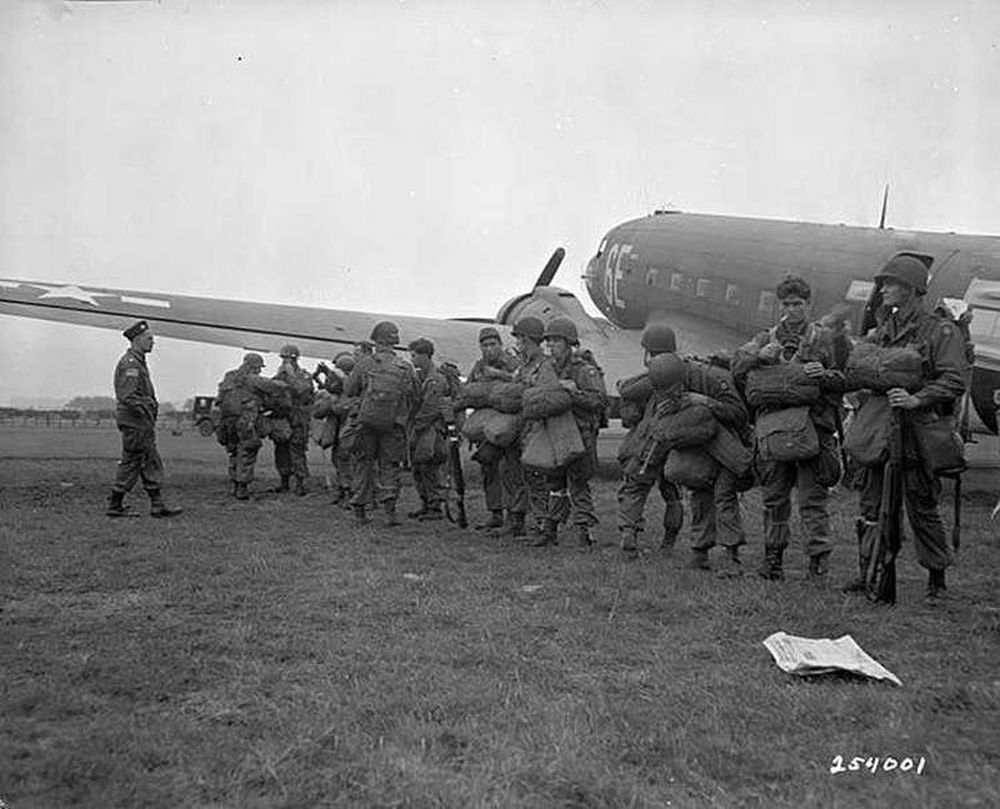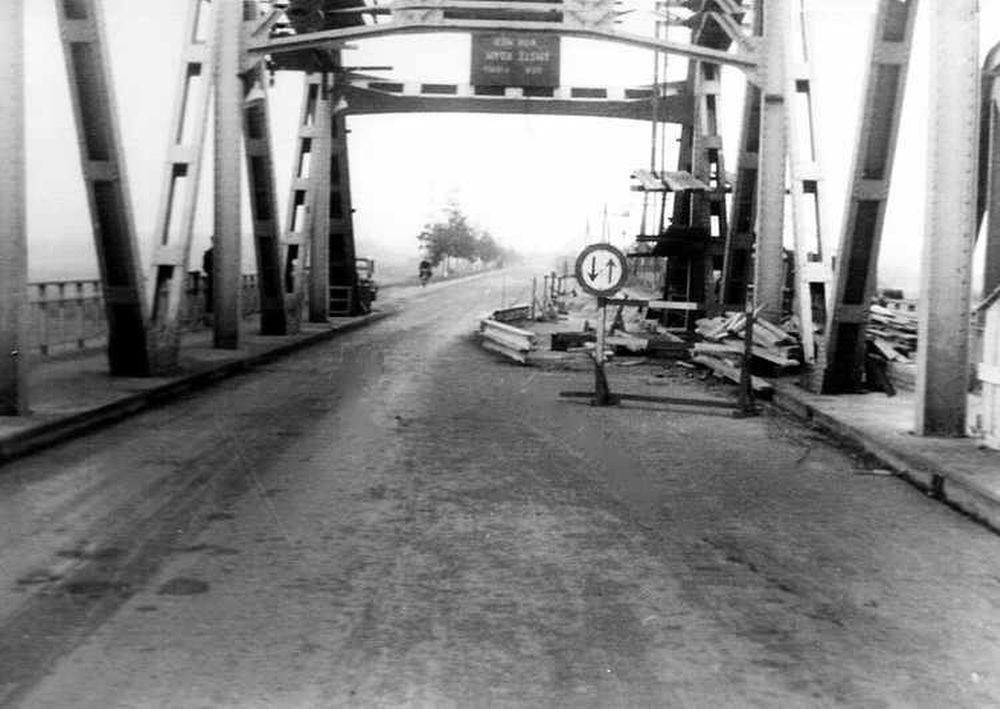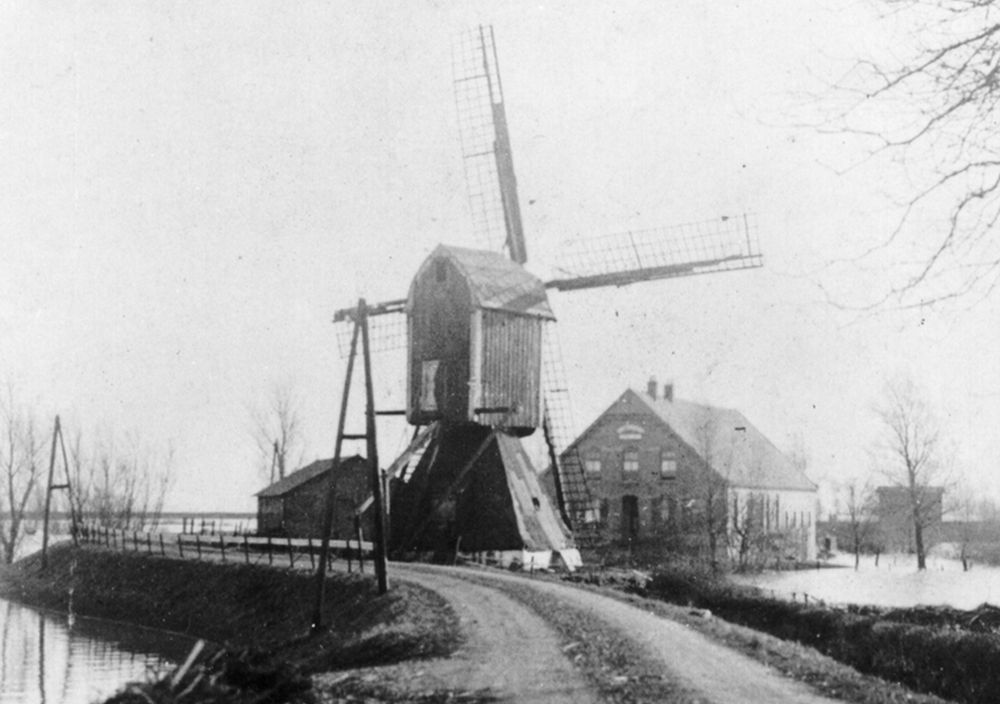Inleiding
Hier vind u de originele tekst van het After Action Report 508th Parachute Infantry Regiment, 7 December 1944. Dit After Action Report beslaat de periode van 17 september 1944 (Operatie Market Garden) tot 11 november 1944. De tekst is aangevuld met relevante afbeeldingen.
Definitielijst
- Regiment
- Onderdeel van een divisie. Een divisie bestaat uit een aantal regimenten. Bij de landmacht van oudsher de benaming van de grootste organieke eenheid van één wapensoort.
PART I - 17 September to 24 September 1944
508th Parachute Infantry enplaned in three lifts at LANGAR and FULBECK airfields, ENGLAND, at 1000 hour, 17 September 1944. The weather was cloudy with a ceiling of 1000 feet over the fields. The three lifts flew in low scattered clouds over ENGLAND, but broke into the clear when they reached the ENGLISH CHANNEL. After departure from ENGLAND the weather was clear and warm.
The flight reached the Dutch coast on schedule, and all check points to the DZ were crossed at the scheduled time. No enemy fighter opposition was encountered. Some scattered flak was encountered at the landfall on the Dutch coast. After leaving the coast of HOLLAND behind no more flak was encountered until fifteen minutes before drop time.
The last fifteen minutes of flight was made through intense light and heavy flak. Machine gun, 20mm and 88mm fire was clearly visible. Casualties among the parachutists from AA fire were light.
The regiment jumped in the following order - 1st Bn, 2nd Bn, 3rd Bn, on DZ "T", 2000 yards north of GROESBEEK, HOLLAND. 1st and 2nd Bn were dropped on the DZ. 3rd Bn was dropped 700 yards southeast of the DZ. Lifts were bunched on the drop facilitating prompt assembly.
Initial enemy resistance on the DZ was negligible, amounting to fire from a few widely scattered AA crews and some isolated labor troops. Generally, the assembly was made without enemy interference.
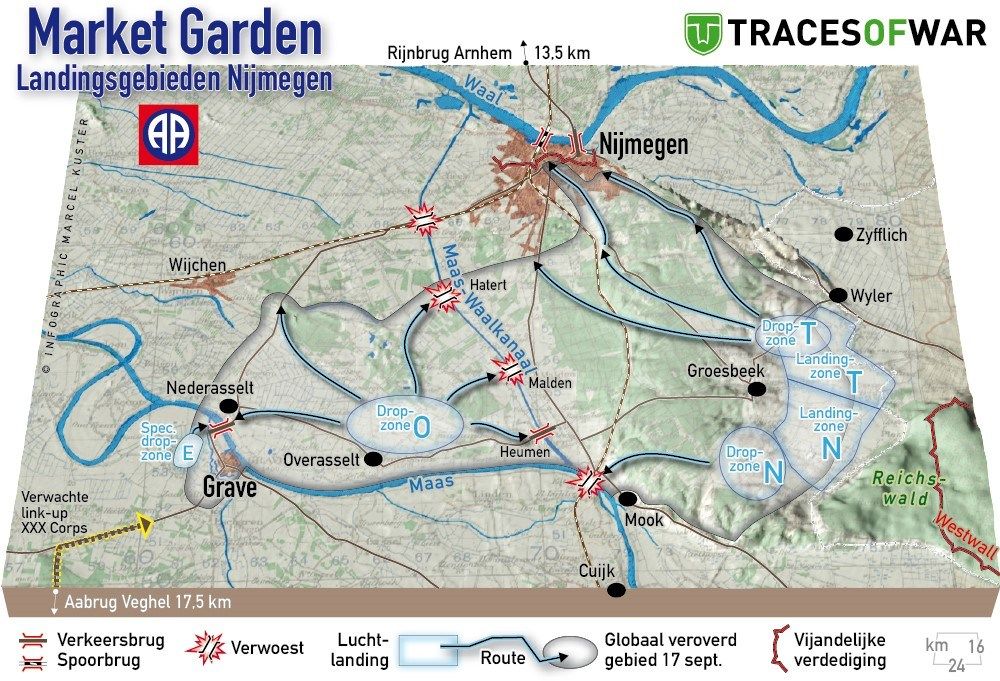
DZ T ten opzichte van de overige landingsgebieden van de 82nd Airborne Division Bron: Marcel Kuster, TracesOfWar.nl
Drop time was 1328 hour, 17 September 44. All units were 90 percent assembled and en route to objectives at 1500 hour. The 1st and 3rd Bns had captured their objectives by 1855 hour, 17 September 1944. The 2nd Bn met more determined resistance and was on its objective at 2030 hour, 17 September 44.
From this point on the action of each battalion constitutes a separate account and will be given below:
(Red: Deze kunnen op de volgende pagina's gevonden worden)
Definitielijst
- flak
- Flieger/ Flugzeug Abwehr Kanone. Duits luchtafweergeschut.
- regiment
- Onderdeel van een divisie. Een divisie bestaat uit een aantal regimenten. Bij de landmacht van oudsher de benaming van de grootste organieke eenheid van één wapensoort.
A. - 1st Battalion: 17 September to 24 September 1944
The 1st Battalion, 508th Parachute Infantry, commanded by Lt. Colonel Shields Warren, Jr., landed on DZ "T" (765585) and assembled rapidly. The battalion had moved to and occupied its assigned initial objective in the vicinity of DE PLOEG (725594) by 1830 hour, five hours after landing. This operation involved a march through enemy territory to the objective three miles from the assembly area.
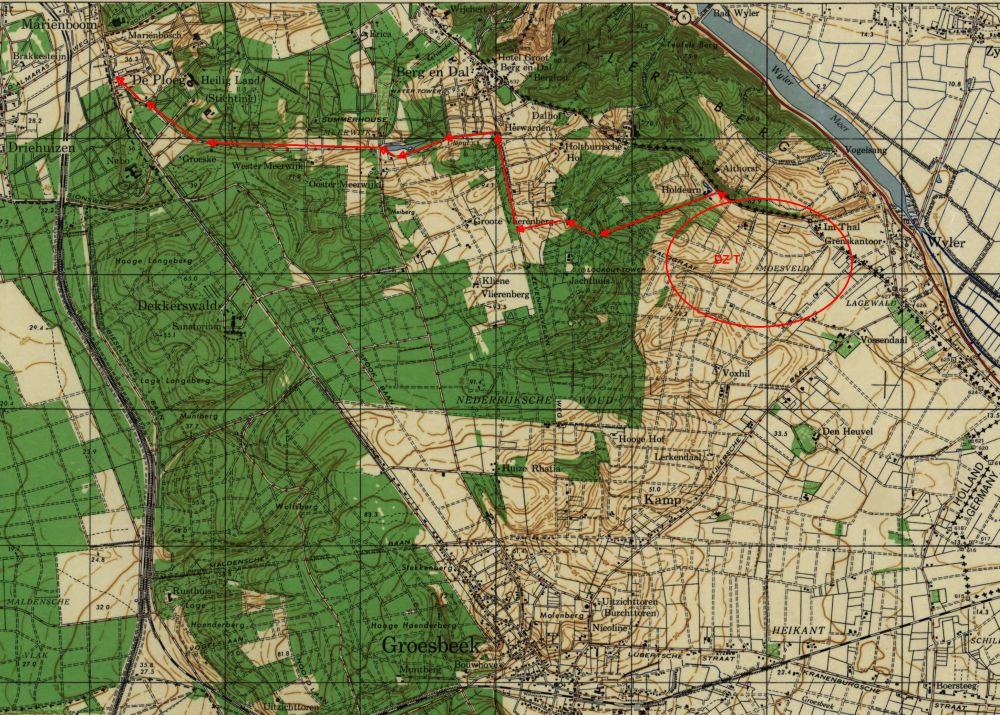
DZ-T en verzamelpunt De Ploeg, met globale marsroute 1st Battalion objective Bron: Wilco Vermeer collection
At 2030 hour, 17 September, Companies A and B moved into the town of NIJMEGEN, to seize the road bridge across the WAAL RIVER, while Company C remained in position holding the high ground at DE PLOEG. Upon entering the town Companies A and B met strong resistance from the enemy garrison supported by armored vehicles. The attack was made with no prior reconnaissance, based on information from Dutch civilians that NIJMEGEN was practically defenseless. After two hours of street fighting in the dark, the action had become localized to platoons, squads, and even smaller groups.
The night of D Day, 17 September, found the 1st Bn deployed as follows: Bn CP in the vicinity of 731591. Company A, followed by Company B, attacking to seize the NIJMEGEN highway bridge, had reached and was fighting in the parkway at 716625. A platoon of Company C plus the Bn S-2 section, by a different route and at an earlier hour had advanced to and fought in the same parkway. This unit returned to Company C and the Bn CP respectively at 0800 hour, 18 September. Company C, less one platoon, was in battalion reserve in the vicinity of the Bn CP.
After bitter street fighting during the night 17-18 September, Company B had pushed through the Company A position to vicinity 708621 by daylight. Shortly after dawn Company A was in the process of reorganizing to push the attack to the final objective when a strong German attack developed on the south regimental flank in the WYLER area. The Germans were already beginning to overrun the glider landing zone located there. At 0800 hour 1st Bn was ordered to send Company C to the vicinity of GROOTE VEIERENBERG (747584) to hold the high ground at that point and to secure a line of departure for a contemplated counterattack to clear the landing zone. Company A and the 81mm mortar platoon returned to the DE PLOEG area, reorganized, and moved out to the southeast prepared to either attack to clear the landing zone or to move east and attack the NIJMEGEN bridge in conjunction with Company G which was making good progress towards the bridge from the southeast. Company B remained in possession of the park at 716625.
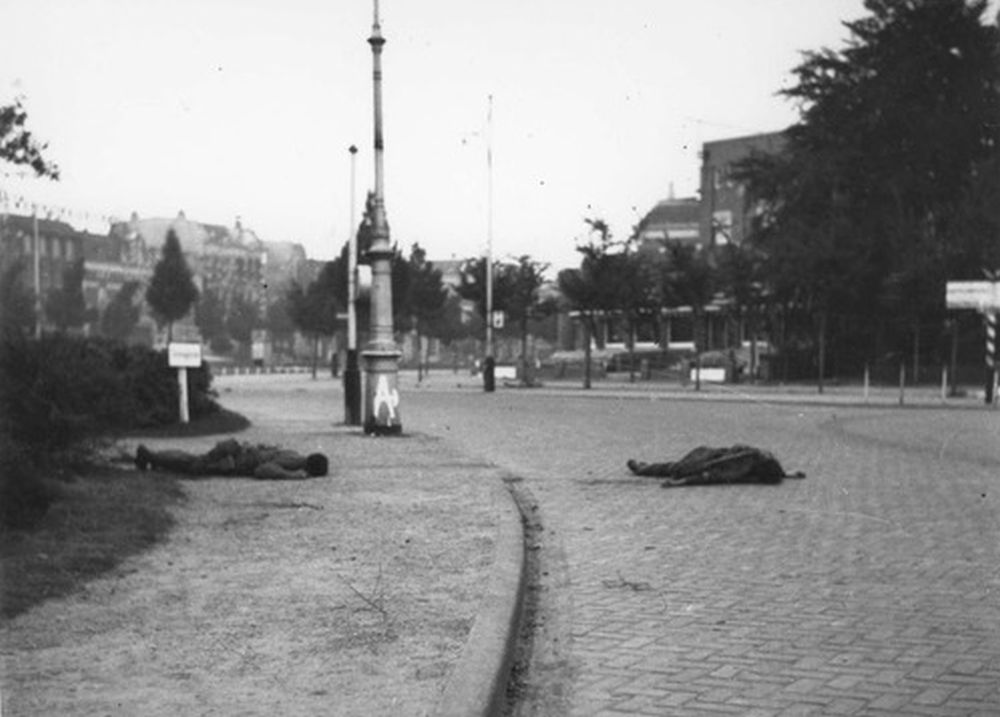
De lichamen van Private Walter Dikoon en Private First Class Ray Johnson na de strijd bij het Keizer Karelplein Bron: US Army photo
By this time Captain Adams and a platoon of Company A, still in NIJMEGEN, had reached and destroyed what is believed to be the control room for the demolition of the bridge. Captain Adams and this platoon were cut off, surrounded, and remained in NIJMEGEN, eventually rejoining their battalion on 22 September. During the time they were cut off, this force was fighting constantly, engaging a superior German force.
On the glider landing zone Company D was engaged in bitter fighting with a much larger German force. By 1100 hour, 18 September, the enemy had surrounded Company D and was threatening to overrun the regimental supply dump. The regimental S-4 had organized the supply personnel into a fighting unit and was evacuating his supplies under enemy fire. The seriousness of the situation necessitated prompt and forceful action.
The 1st Bn was ordered to attack without delay to drive the enemy from the landing zone with the KAMP-LAGEWALD road the battalion objective. Company B move from NIJMEGEN to DE PLOEG to rejoin the remainder of the battalion. From there Colonel Warren moved his unit to the line of departure at GROOTE VEIERENBERG, now secured by Company C.
At 1230 hour the battalion attacked, Companies B & C abreast, Company C on the right. The CP group followed in the center at 300 yards, with Company A following Company B at 400 yards, in battalion reserve. Emerging from the woods 600 yards northwest of VOXHIL, the companies encountered heavy small arms fire but quickly pushed beyond the first high ground. A Bn CP was established in the vicinity of 762578. Continuing the attack at a run, Companies B and C cleared enemy opposition in the vicinity of VOXHIL-VOSSENDAAL, 7757. Company A, less one squad which cleared the high ground on the left flank (vic. of 764583), pushed rapidly up WALDGRAAF ROAD to the vicinity of VOSSENDAAL-WYLER (781583). The 1st Bn seized its objective at 1400 hour, as the gliders were coming in to land.
In this action the battalion killed approximately 50 Germans and captured 149. The battalion also neutralized 16 20mm guns which had been firing on the landing zone. Up to this point losses were light, due to the speed of the attack. (Four WIA in the CP group, two KIA and five WIA in the rifle companies).
Two squads on the left flank in the vicinity of 763583 reported that an indefinite number of Germans were moving from the vicinity of ALTHORST (767587).
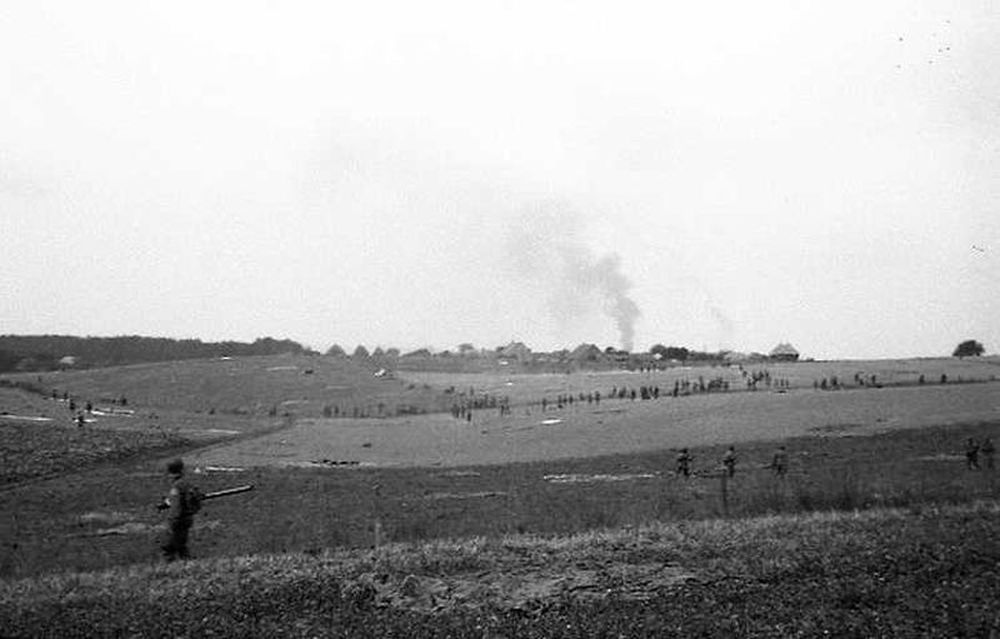
Leden van 508th PIR maken DZ-T vrij voor de aankomende gliders Bron: 508th Parachute Infantry Regiment
The Bn CO had Company A organize a defensive position in the vicinity of the high ground 200 yards northeast of the WALDGRAAF ROAD near 763583. Company B occupied the high ground in the vicinity of VOXHIL, 767583-765567. All companies established an outpost system 200 to 600 yards in front of this MLR before dark. Bn CP was established in vicinity of 757575. Company C made contact on the right flank with the 505th Parachute Infantry in vicinity of KAMP (763563).
During the night and early the next morning the line was extended to vicinity of TEUFELS BERG (764597) - ALTHORST (767587) - high ground (763583) - high ground (765576), with a platoon roadblock at WYLER and a point at 778580. Company E took over the VOXHIL area on the right flank.
Principal features of this series of quickly changing events were:
(1) The excellent control of all echelons of the battalion from the time of the drop through the period of this narrative.
(a) The rapid movement to and occupation of the first objective.
(b) The daylight withdrawal from the town in the face of German resistance.
(c) The rapid move to a directionally opposite objective.
(d) The attack from the correct area after a 2000 yard deployed march, much of it through heavy woods.
(e) The dashing attack, almost on a run, for 1000 to1200 yards in the face of 20mm, 40mm, and small arms fire.
(f) The prompt reorganization and movement without casualty to a chosen defense line, followed by prompt outposting and digging in.
(2) The excellent timing in employment of the battalion reserve for exploitation of a reeling enemy on the landing zone.
(3) The rapid decisions and orders of the Bn CO, who after an all night street fight, throughout the next day, vigorously led the battalion on a rapid approach march
followed by a fast attack and reorganization.(4) The movie-thriller sight of landing gliders on the LZ as the deployed paratroops chased the last of the Germans from their 16 20mm guns.
At 1530 hours on the 19th CO Company A (Lt Foley, commanding in the absence of Captain Adams, who was still fighting in NIJMEGEN) was alerted for an attack on HILL 75.9. Company A at this time consisted of 2 officers and 42 men from the original company plus an attached platoon of Company G numbering 34 men and 1 officer. At 1600 hours the Bn CO ordered Company A to seize and hold HILL 75.9 and established a roadblock at its base, where the BAD WYLER causeway met the main highway (765598).
The attached platoon of Company G had been beaten off the hill three times during the morning by an estimated company of German paratroopers. With the enemy on the eastern, western and northern slopes of HILL 75.9 Lt. Foley led his company through the woods, approaching the crest from the south and arrived at the LD undetected. 200 yards south of the crest. Company A deployed and charged the crest at a run. The Germans on the summit were literally yelled out of their holes, but recovered on the slopes and fought bitterly from positions on the hillside. They counterattacked repeatedly, supported by eight LMG's, but the men of Company A, fighting from hole to hole, gradually drove them down the very steep hill.
At 1800 hours on the 19th Company A's five light machine guns were emplaced on the crest, from where they fired on the Germans as they fled north across the open ground and southeast down the highway to WYLER. A Company lost ten men killed (all shot in the head) and seven wounded. Enemy dead littered the hillsides. At the foot of the hill the enemy left three motorcycles, two staff cars, a truck in running order and another truck which was damaged, two intact 20mm cannons with 300 rounds of ammunition, thirty odd rifles, and most of their miscellaneous individual equipment.
At twilight the company reorganized and took up positions in the foxholes vacated by the enemy. Owing to the long battalion front (approximately 2000 yards) Company A was almost isolated from the remainder of the battalion, and it was extremely easy for the enemy to infiltrate in force through the wooded hills around the company. During the night, however, a carrying party of twelve men under Lt. Kelly (Bn S-4) reached the hill with ammunition. In the morning Company C on Lt. Col. Warren's order, flushed the area around DEVIL'S HILL, seizing 12 prisoners who had fled from the hilltop toward HOLLAND instead of into GERMANY during the previous days' attack. The prisoners evacuated our wounded. Two British M-10's, approaching from the 3rd Bn area, picked up 10 wounded Germans in the area who had been unable to retreat with their company.
At the same time that Company A was completing the capture of HILL 75.9, Company B, less one platoon, was attacking WYLER. After driving out the German garrison, estimated at one company, Company B quickly reorganized and established a defensive position and a roadblock at the main junction in the town. The roadblock was reinforced with two 57mm AT guns. At daylight the following morning four prisoners were captured in the houses of the village.
At approximately 0800 hour, on the 20th, a German truck carrying supplies and 10 men approached the roadblock from the southeast. One of the 57mm guns fired and a MG fired on the truck. The truck was disabled and all except three Germans, who escaped along a road ditch into the woods, were killed. At about 0810 a motorcycle approached from the same direction. The rider saw the demolished truck, turned and rode away before he could be killed. At 0845 hour enemy infantry, estimated at one company, was seen moving across the open ground from southwest to northeast at a distance of about 800 yards from the road block. The enemy was partially concealed by the heavy mist and moved out of sight in the hedgerows and ditches towards GERMANY. At 0930 hour the road block received ten rounds from an enemy artillery piece (88mm or 75mm) located in ZYFFLICH, GERMANY (7859). Artillery fire was adjusted on the gun position by 300 radio and no more fire was received from there. At 0950 hour the roadblock received fire from two enemy 20mm guns located in ZYFFLICH, and from enemy MG's at 792587. At the same time it was discovered that troops (estimated two companies of infantry) were advancing from the north and northeast. An artillery barrage was called for immediately and it broke up the enemy attack on both fronts. About an hour an a half later the enemy again advanced in force, firing MG's and small arms. The fire was returned, and a fight began; at the same time sniper fire broke out from several houses in the village. The Germans set fire to a couple of buildings and under cover of the smoke began to infiltrate around the road block. The enemy advance continued across the field developing into a strong attack of battalion strength, well supported by artillery.
During the night 19-20 the enemy activity in Company A's sector increased. At dawn a company of enemy, with artillery and mortar support, attacked the hill, making fanatical assaults up the hillside. In the middle of the firefight German fire ceased and a well-dressed German officer stepped into the open calling on A Company to surrender. Lt. Foley replied, "If you want me, come and get me!", and ordered his men to resume fire. The fight continued for an hour before the attack was repulsed. Company A suffered one casualty, killed by an artillery tree burst.
On September 21st, Lt. Havens and 14 men, who had been holding high ground to the south, rejoined the company. An hour after they had left their former position German machine guns were still firing on it. Lt. Havens placed his men to the "rear" of the company (the south side) just in time to assist in repulsing the final and most bitter attack. On the next day Captain Adams, Lt. Lamm and the remainder of the 1st platoon returned to the company from NIJMEGEN.
From 20-23 September, Company A repulsed four attacks in company plus strength. Attacks were made by parachutists (fighting as regular infantry), plus marines and flak troops. The parachutists were especially fanatical, at one time charging to within 15 feet of the machine guns located 300 feet above the road on the hilltop. Attacks were made from three and four sides at once. Food and ammunition were extremely short. At one time a patrol of selected NCO's sent to battalion for ammunition, returned (with 4 bandoliers, 1 box of LMG, and 200 rounds of TSMG, apiece) to find that the enemy had attacked in their absence, that automatic weapon ammunition had been entirely expended, and that the riflemen were down to an average of five rounds (not clips) apiece. One rifleman asked his squad leader where the company would withdraw when out of ammunition and was told, "We can withdraw straight up or straight down and that's all." The constant attacks and enemy night infiltration allowed the men of Company A very little sleep. At night men in adjoining foxholes tied bandoliers to each other to pull each other awake. A German paratrooper, with a beltful of grenades, was shot one night within a few feet of a foxhole. However, during the remainder of their defense of "Devils Hill", only one more Company A man was killed.
The following episode deserves special mention: Two plane loads from Company A were erroneously dropped approximately two miles east of the drop zone in German territory. Lt. Combs, the senior officer present, fought his way back to his battalion, killing an estimated 20 Germans and bringing back 49 German prisoners. Lt. Combs had 22 men in the group which accomplished this. Lt. Combs carried out this action after having been wounded by flak prior to jumping.
Definitielijst
- flak
- Flieger/ Flugzeug Abwehr Kanone. Duits luchtafweergeschut.
- paratroopers
- Luchtlandingstroepen. Militairen die gespecialiseerd zijn in parachutelandingen.
- section
- Historically a section is one of the smallest units within the army. In the French era two sections formed a platoon. During the eriod prir to the SecondWorld War, within the Dutch Army, a section was the equivalent of what after thewar was called a platoon.
- sniper
- Militaire sluipschutter die op lange afstanden (tot ca. 800 meter) individuele doelen kan uitschakelen.
B. - 2nd Battalion: 17 September to 24 September 1944
The 2nd Battalion, commanded by Major Otho E. Holmes, landed on DZ "T" and assembled without delay. Initially Company D, under regimental control, had the mission of seizing, clearing and holding LZ "T" for glider landings.
With his battalion, less Company D, Major Holmes had to occupy a defensive sector more than three thousand yards wide. Moving four and a half miles through hostile territory against enemy opposition, the 2nd Battalion seized and organized its objective at DE HUT (704592) within seven hours after dropping.
Early on the morning of 18 September the 2nd Battalion was ordered to seize bridge #10 (672604) across the MAAS-WAAL CANAL. This mission had not been assigned to this regiment originally, but was undertaken as a result of the unusual tactical situation. Bridge #10 was the only bridge across the MAAS-WAAL CANAL remaining undestroyed.
At 0330 hour, 18 September, 1st Lt. Polette, with a platoon started to move towards bridge #10. The group moved to a point 300 yards east of the bridge where it was stopped by small arms, automatic weapons and mortar fire. In the darkness, the enemy fire was not accurate, but as the sun rose higher, the accuracy and intensity of the fire increased. Lt. Polette's attacking platoon continued to press the assault and worked their way to within 150 yards of the bridge. Here the intensity of the fire did not permit further advance without supporting weapons and Lt. Polette requested support from the 81mm mortar platoon. Meanwhile he disposed his light machine gun and BAR's as to bring fire of maximum effect on the enemy. Soon after they opened fire from their advanced positions the LMG's were put out of action by German mortar fire.
As the fight went on, small groups of enemy could be observed preparing the demolitions around the railroad and highway bridge. Each time the enemy would commence work, Lt. Polette's riflemen would drive them back to cover. At 1030 hour the enemy blew the charges, destroying the railroad bridge and damaging the highway bridge. At 1100 hour a section of 81mm mortars arrived and immediately went into action against the enemy around the bridge. The intensity and accuracy of this fire caused the enemy to withdraw, leaving the highway bridge only slightly damaged. Lt. Polette reorganized his depleted platoon and established a defensive position at the bridge. At about the same time a small patrol from the 504 Parachute Infantry arrived and contacted the group under Lt. Polette. Lt. Polette's force remained in position defending the bridge until recalled by his battalion commander at 1730 hours. By this time a company from the 504 Parachute Infantry had arrived at the bridge and was able to take over responsibility for its defense.
The 2nd Battalion, less D Company, maintained its defensive position until 1600 hour, 18 September, at which time the sector was reduced to a width of 2000 yards and Company F was detached and attached to the 3rd Battalion. This detachment left the 2nd Battalion, less two rifle companies, holding the sector. At 1200 hour, 19 September, British armored units reached the 2nd Battalion positions.
On 20 September the 2nd Battalion, less Company F, moved to and established a defensive position along the line KEMP-VOXHIL. The battalion remained in this position until 24 September, at which time it was relieved by the 504 Parachute Infantry.
Definitielijst
- regiment
- Onderdeel van een divisie. Een divisie bestaat uit een aantal regimenten. Bij de landmacht van oudsher de benaming van de grootste organieke eenheid van één wapensoort.
- section
- Historically a section is one of the smallest units within the army. In the French era two sections formed a platoon. During the eriod prir to the SecondWorld War, within the Dutch Army, a section was the equivalent of what after thewar was called a platoon.
- tactical
- Tactic betekent taktiek. De werkelijke uitvoering van het militaire bedrijf. De Amerikanen gebruikten de term Tactical ook om luchtmacht onderdelen aan te duiden die aanvallend optraden, zoals jagers en jachtbommenwerpers. Dit in tegenstelling tot Strategical, waarmee bommenwerper eenheden werden aangeduid.
C. - 3rd Battalion: 17 September to 24 September 1944
The 3rd Battalion, 508th Parachute Infantry, commanded by Lt. Colonel Louis G. Mendez, Jr., landed several hundred yards southeast of DZ "T", assembled quickly, and occupied its initial objective, the high ground in the general area BERG EN DAL-UBBERGEN-BEEK at 1830 hour, without serious resistance. The success of all operations in the NIJMEGEN area depended to a great extent upon the retention of this high ground by the 3rd Battalion.
Late in the afternoon of 17 September, Company G seized HILL 64 (732616). At midnight the company attacked to seize the NIJMEGEN highway bridge, advancing to a point within 400 yards of the bridge by the next morning. Due to a heavy enemy attack on the southern perimeter of the Regimental area at WYLER, and to a serious threat at BEEK, Company G had to be moved to the high ground north of BERG EN DAL, before it seized the bridge.
The situation demanded that the enemy be denied the use of the NIJMEGEN WYLER road (Highway K). By the afternoon of the 19th, road blocks had been established at the main intersection in BERG EN DAL and on Highway K at BEEK. Company D, 307 Engineer Battalion and four 57mm AT guns were placed at the roadblock in BEEK and two at the block in BERG EN DAL.
Throughout the 19th much enemy movement had been observed in the area behind BEEK, and the general opinion was that an attack was imminent. As the enemy would concentrate his activity at a particular place, apparently massing for an effort, our artillery would force him to disperse.
On 20 September, the Germans began to systematically shell the positions in BEEK and BERG EN DAL, causing some casualties. In the late afternoon an attack by enemy armor and infantry developed at BEEK. The platoon road block was overrun and the enemy advanced almost to BERG EN DAL. Company H counterattacked, and reestablished the BEEK position at 2140 hour, after a bitter fight.
The enemy wanted BEEK, and to get it they threw in an immediate counterattack in greater strength than before. By dawn a portion of Company H was completely surrounded. The 3rd Battalion launched a full scale attack, one platoon of Company G attacking from the northwest, while Company F attacked from the southeast. What remained of Company H made the frontal assault. The initial attack made very little progress. Losses to both sides were very heavy. The enemy came forward in another attack, attempting to press his temporary advantage by pushing southwest from BEEK to towards BERG EN DAL and southeast towards WYLER. This effort met with no success. In the early afternoon the 3rd Bn renewed the attack with a ferocity which sustained Lt. General Dempsey's reference to the 82nd Airborne Division as "The finest fighting division in the world." By 1815 hours BEEK was ours, and from this time on no live Germans, except prisoners, were in the town again.
On the 22nd September orders were issued for the 3rd Battalion to attack and clear the enemy from the eastern portion of the CIRCUL VAN DE COIJ and establish the MLR along the new line SMOREN HOOK-QUER DAM-DAM ERLEKON.
Company I, supported by a troop of tanks from the Sherwood Rangers Yeomanry, initiated a reconnaissance in force and reached WERCHEREN by 1610 hours. At the south end of WERCHEREN LAKE Company I encountered enemy estimated at two companies in well dug-in positions, supported by AT guns and artillery. Company I was unable to advance through or around this enemy position, and at 1800 hours, after suffering moderate casualties, returned to the hills overlooking BEEK. Preparations were initiated for an attack to be launched the next day.
At 0430 hours, 23 September, the 3rd Battalion moved out to a rendezvous near POLDER. The attack began at 0710 hours, with companies echeloned to the left rear, in order from right to left, Company G, Company H, Company I. A troop of tanks was attached to each company.
On the north flank, Company I overcame enemy resistance easily, and reached the objective in the ERLEKOM brick kilns at 0830 hours. Company H reached its objective at HILL 9.2 (774624) with no resistance being encountered. Company G ran into the center of enemy resistance and reached its objective (THORENSCHE MOLEN) at 0815 hours after a fierce fight. The enemy counterattack caught Company G in the midst of reorganization and resupply and forced it back six hundred yards to the WERCHEREN LAKE.
In the afternoon (23 September) Company G attacked and regained the THORENSCHE MOLEN position. The enemy concentrated artillery fire on the company position and engaged our forces with small arms, mortars and automatic weapons. It was decided to move Company G to the vicinity of WERCHEREN LAKE and organize that ground for defense. By nightfall Company G was in position and firmly established.
At 2100 hours the enemy launched a coordinated attack on Companies G and I, which was repulsed after heavy fighting. In the course of the battle Company I damaged a PzKw tank.
On the morning of the 24th September Company G made its third attack on THORENSCHE MOLEN and for the third time drove the enemy from the position. The enemy resumed their bombardment of the dikes, and it was decided that the mounting casualty rate did not warrant retention of the tactically valueless position. On Regimental order Company G returned to the WERCHEREN LAKE positions and organized the MLR at that point.
On the evening of the 24th September the 3rd Battalion was relieved by the 3rd Battalion, 504 Parachute Infantry.
In eight days of fighting the 3rd Bn had attacked six times, had withstood five enemy attacks, and had driven the Germans from twelve thousand square meters of GERMANY and HOLLAND. In these actions the 3rd Battalion lost 40 killed, 120 wounded, and 36 missing in action. 146 German prisoners were taken and an estimated 100 enemy were killed.
D. - General
At 1600 hours, 24 September, 504 Parachute Infantry began relief of the regiment in the entire sector. By 2345 hours the relief had been completed and all units of the regiment went into Division Reserve.
Definitielijst
- regiment
- Onderdeel van een divisie. Een divisie bestaat uit een aantal regimenten. Bij de landmacht van oudsher de benaming van de grootste organieke eenheid van één wapensoort.
PART II - 24 September to 5 October 1944
The regiment remained in Division reserve until 29 September. At 1850 hours 28 September 3rd Battalion was placed under Division control as Division reserve. At 0110 hours 29 September the 2nd Battalion relieved the 3rd Battalion, 504 Parachute Infantry, on the MLR in the VOXHIL area. At the same time the 1st Battalion went into position on the RRL in the rear of the 2nd Battalion.
On the night of 29 September the 2nd Bn sent two combat patrols to DEN HEUVEL and the woods southeast of there. The patrol on the south reached its objective after some fighting. In DEN HEUVEL, a violent small scale battle was fought. The patrol penetrated DEN HEUVEL some two hundred yards, fighting from hole to hole. Enemy in the woods were deeply entrenched with overhead cover. As the patrol advanced each dugout had to be cleared out individually. Eight German machine guns and a 20mm flak wagon brought fire on the patrol. The patrols returned with four prisoners. While the patrols were keeping the enemy occupied along the front, attached Engineers from Company D, 307th Engineer Battalion, laid a mine field across the front of the VOXHIL position.
On the following day the enemy began intensive shelling of our forward, reserve and regimental command post areas. Light, medium, and heavy artillery were employed. At midnight 1 October the enemy culminated an extremely heavy barrage with an infantry attack supported by armor. The rear area barrages were extremely effective in cutting all wire communication between battalions, regiment, and division.
At 0005 hour D and E Companies were attacked by enemy estimated at a battalion of Panzer Grenadiers supported by tanks, engineers, assault guns and artillery. The weight of the attack drove the right platoon of Company E back seven hundred yards. F Company counterattacked from its reserve position at 0400 hour and restored the original position at 0430 hours. Company D destroyed a Panther Tank with bazooka fire at 20 yards. The attack cost the 2nd Battalion 9 men killed and 38 men wounded. Twenty prisoners were captured. At dawn it was discovered that the 2nd Battalion had destroyed one Panther Tank, three half tracked personnel carriers and two self propelled assault guns during the night.
On the night of 3-4 October demolition personnel, led by 1st Lt. Donald W. Hardwick, set fire to the abandoned and partially damaged enemy vehicles.
Subsequently the enemy confined his activities to sniper and harassing artillery action until the night of 5-6 October at which time the regiment was relieved in this sector by the 325 Glider Infantry Regiment.
Definitielijst
- flak
- Flieger/ Flugzeug Abwehr Kanone. Duits luchtafweergeschut.
- regiment
- Onderdeel van een divisie. Een divisie bestaat uit een aantal regimenten. Bij de landmacht van oudsher de benaming van de grootste organieke eenheid van één wapensoort.
- shelling
- Aanduiding voor het beschieten van doelen met granaten. Kan zowel vanuit artillerie- als pantsergeschut zijn.
- sniper
- Militaire sluipschutter die op lange afstanden (tot ca. 800 meter) individuele doelen kan uitschakelen.
PART III - 6 October to 16 October 1944
On 6 October, the regiment with 319th FA Battalion, Company D, 307th Engineer Battalion, and Battery B, 80th AA AT Battalion, attached, moved to the vicinity of BEMMEL, HOLLAND, and relieved the 231st Brigade (British) on the front. The Combat Team was attached tactically to the 50th British Division.
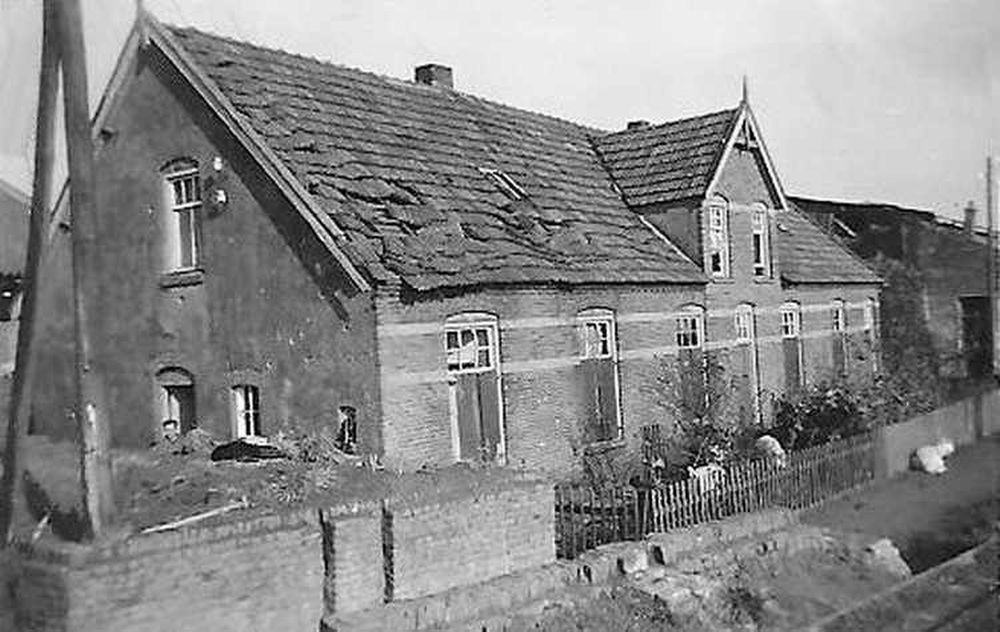
CP te Bemmel, waarschijnlijk van 508th RCT, aan Het Oude Kerkhof tegen de dijk. Bron: 508th Parachute Infantry Reigment
Upon moving into its area the 3rd Battalion found numerous anti-personnel mines in its area. Thirty-two British anti-personnel mines were recovered in the area.
At 1200 hours, 7 October, the regiment was attached to the 53rd British Division and remained in the same sector.
The enemy in this area showed little offensive spirit, and seemed content to attempt to restrict our activities to the southwest side of the WETERING LINGE. He maintained numerous automatic weapons along the dike and covered the extremely flat terrain with bands of interlocking fire. At night his artillery was extremely active along the front line and in the rear areas.
Our patrols kept in close contact with the enemy, patrolling up to the dike every night.
One patrol in particular deserves special mention. Corporal Smith and Pfc. Heath on 15 October, crossed the WETERING LINGE and moved northeast to the PANNERDENCHE KANAAL, some four thousand yards behind the enemy front lines. They continued to move through enemy territory throughout the day, gathering much useful information. At nightfall the pair moved back to our lines, stopping once en route to pull a German soldier from his hole. By 2300 hour, 16 October, Cpl. Smith and Pfc. Heath, accompanied by their prisoner, were back in friendly territory.
Definitielijst
- Brigade
- Bestond meestal uit twee of meer Regimenten. Kon onafhankelijk of als een deel van een Divisie dienen. Soms waren ze deel van een Korps in plaats van een Divisie. In theorie bestond een Brigade uit 5.000 - 7.000 man.
- regiment
- Onderdeel van een divisie. Een divisie bestaat uit een aantal regimenten. Bij de landmacht van oudsher de benaming van de grootste organieke eenheid van één wapensoort.
PART IV - 16 October to 11 November 1944
The regiment, attached to the British 53rd (Welsh) Division, continued to occupy its defensive position. Enemy activity was confined to shelling and mortaring, which was usually light. Our patrol activity continued, and we harassed the enemy nightly with artillery, mortars and machine guns fire.
On 17 October command of the sector passed to the British 50th (Northumbrian) Division; the 508th Combat Team was attached to the Division and remained on position.
Although activities on our front were confined mostly to night reconnaissance and combat patrols, two daylight patrols are well worth mentioning. At 0930 hour on October 28th 1st Lt. Rex G. Combs and two men crossed the WETERING LINGE CANAL and moved along it for several hundred yards. They encountered a squad of enemy which showed signs of surrendering at first, but eventually placed heavy fire on the three men, slightly wounding Lt. Combs. 1st Lt. William H. Cross and two men crossed the WETERING LINGE, at a point farther south, at 1200 hour the same day. They found one German asleep in his hole and were about to take him prisoner when four more Germans showed themselves and apparently would have surrendered had not an enemy machine gun on the patrol's left flank opened fire. This aroused all of the enemy into furious activity. 1st Lt. Cross was wounded in this action and the patrol withdrew.
The 3rd Battalion also sent a three man patrol out at 0900 hour, October 28th, but while crossing the canal drew heavy enemy fire. The patrol withdrew with one member missing in action.
At 2300 hour, 28 October, the Regimental Combat Team, less the 319th FA Battalion, was relieved and sent to a rest area in NIJMEGEN, where personnel took advantage of shows, baths, and much needed sleep. While in the rest area the officers and NCO's were addressed by Lt. General Horrocks, commanding the XXX British Corps(red: XXX Corps), on the history of the campaign of the Low Countries.
On 2 November the Combat Team returned north of the river and relieved the 231st Brigade (British) in the BEMMEL area. Enemy activity on our front was much the same as before, except that the enemy was slightly more aggressive.
On 10 November the regiment was relieved by the 69th Brigade (British) and all units reverted to control of the 82nd Airborne Division. By 2400 hour, 10 November, the regiment had closed in billets in NIJMEGEN. The following day the regiment marched a distance of 18 miles to OSS, HOLLAND. On 12 November the regiment moved 90 miles, by motor, to BOURG LEOPOLD, BELGIUM. The next day, 13 November, the regiment continued on, by truck, to CAMP SISSONNE, FRANCE.
Definitielijst
- Brigade
- Bestond meestal uit twee of meer Regimenten. Kon onafhankelijk of als een deel van een Divisie dienen. Soms waren ze deel van een Korps in plaats van een Divisie. In theorie bestond een Brigade uit 5.000 - 7.000 man.
- regiment
- Onderdeel van een divisie. Een divisie bestaat uit een aantal regimenten. Bij de landmacht van oudsher de benaming van de grootste organieke eenheid van één wapensoort.
- shelling
- Aanduiding voor het beschieten van doelen met granaten. Kan zowel vanuit artillerie- als pantsergeschut zijn.
PART V - GENERAL
Throughout the history of the first fifty-seven days of this, the liberation of HOLLAND, little mention has been made of the supporting arms which made the successes of the 508th Parachute Infantry possible. Not enough credit can ever be given to the 319th FA Battalion. The superior manner in which our artillery responded to every request, delivering fire promptly and accurately, made difficult tasks easy and often was the deciding factor. The men of Company D, 307th Engineer Battalion and Battery B, 80th AA AT Battalion, were not mentioned specifically in any of the foregoing accounts, but without their support much of this history would have been changed.
During the operations of the regiment with the British 50th Division, it had in support, in addition to the attached 319th FA Battalion, the 90th Field Regiment (British), elements of the 4.2 Mortar Company and Medium Machine Gun Companies of the 2nd Cheshire Regiment. An effective system of immediate retaliation fires was established enabling us to place fire on known enemy infantry positions on a retaliatory basis of three shots to one.
Definitielijst
- regiment
- Onderdeel van een divisie. Een divisie bestaat uit een aantal regimenten. Bij de landmacht van oudsher de benaming van de grootste organieke eenheid van één wapensoort.
RESULTS OF OPERATIONS
1. Established and maintained a defensive position along an MLR over twelve thousand yards in length, with enemy on three sides of the position.
2. Seized Bridge #10 and prevented its destruction.
3. Destroyed the apparatus for the demolition of the NIJMEGEN BRIDGE across the WAAL RIVER, thus making possible the successful completion of the major Division mission.
4. Seized, occupied, organized and defended the BERG EN DAL- KAMP HILL mass, terrain which controls the GROESBEEK-NIJMEGEN area.
5. Cut Highway K, preventing movement of enemy reserves or escape of enemy along this important international route.
6. Withstood and repulsed the major enemy efforts at WYLER and at BEEK to penetrate the Division position and isolate the units to the north.
7. Captured 483 prisoners.
8. Sustained casualties as follows:
Killed in Action: 139
Wounded in Action: 479
Missing in Action: 78
Captured:
9. Was first Allied Airborne unit to operate tactically in GERMANY.
10. Captured first prisoners of war in GERMANY to be secured by Allied Airborne Troops.
PERSONNEL OF 508TH COMBAT TEAM
Colonel Roy E. Lindquist C.O. 508 Prcht Inf
Lt. Col. T.J.B. Shanley Ex. O. 508 Prcht Inf
Lt. Col. Shields Warren C.O. 1st Bn, 508 P I
Major Otho E. Holmes C.O. 2nd Bn, 508 P I
Lt. Col. Louis G. Mendez C.O. 3rd Bn, 508 P I
Lt. Col. James C. Todd C.O. 319 F.A. Bn
1st Lt. Charles W. Chaplinski C.O. Co. D, 307 Engr Bn
1st Lt. John C. Cliff C.O. Btry B, 80 AA Bn
Informatie
- Artikel door:
- Wilco Vermeer
- Geplaatst op:
- 06-03-2015
- Laatst gewijzigd:
- 17-12-2020
- Feedback?
- Stuur het in!
